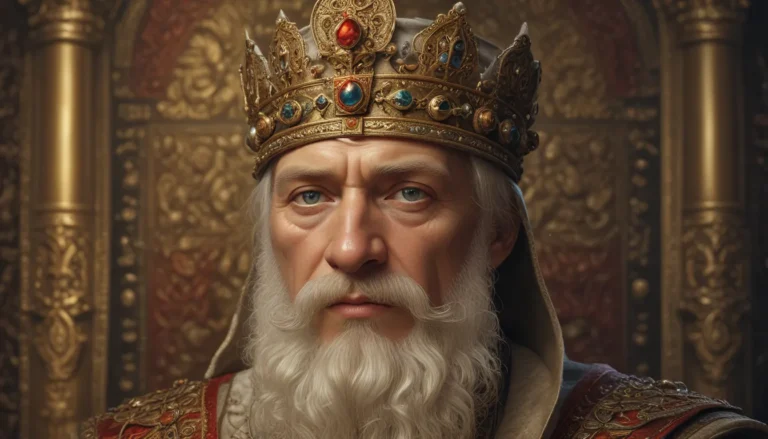The images in our articles may not match the content exactly. They are used to grab your attention, not to show the exact details in the text. The images complement the text but do not replace it.
Welcome to a journey into the remarkable life of Hernando De Soto, a name synonymous with exploration and conquest. From his early beginnings in Spain to his legendary expeditions in the New World, De Soto’s story is one that continues to captivate historians and enthusiasts alike. Join us as we uncover 20 intriguing facts about this intrepid explorer and the lasting impact he had on the course of history.
Early Life and Background
Hernando De Soto was born in Jerez de los Caballeros, Spain, in 1496, into a noble family. His upbringing instilled in him a sense of adventure and curiosity that would shape his future endeavors as a renowned explorer.
A Journey to the New World
At the young age of 18, De Soto embarked on his first voyage to the New World in 1514. This marked the beginning of a lifelong exploration that would lead him to uncharted territories and new discoveries.
Accompanying Francisco Pizarro
De Soto joined Francisco Pizarro’s expedition, the conqueror of the Inca Empire, where he gained recognition and valuable experience that would influence his future conquests.
Exploration of Florida
From 1539 to 1543, De Soto led the first European expedition deep into the southeastern region of the United States, exploring and claiming Florida for the Spanish crown.
The Mississippi River Discovery
In May 1541, De Soto’s expedition became the first Europeans to set eyes upon the mighty Mississippi River, a significant achievement that added to his legacy as an explorer.
A Wealthy Conquistador
De Soto’s astute business acumen and success in ventures and conquests allowed him to amass considerable wealth, investing in plantations and mining operations.
A Ruthless Conqueror
Despite his remarkable expeditions and discoveries, De Soto was known for his ruthless tactics towards Native American populations, marked by violence, enslavement, and exploitation.
Searching for El Dorado
Like many explorers of his time, De Soto embarked on a quest to find the legendary city of El Dorado, though he was unsuccessful in his pursuit. His efforts, however, contributed to expanding knowledge about the New World.
Legacy of Disease
De Soto’s expeditions unintentionally introduced diseases to indigenous populations, leading to devastating consequences such as the spread of smallpox and significant decline among Native American communities.
Death and Burial
Tragically, De Soto’s journey came to an end in 1542 when he passed away due to fever on the banks of the Mississippi River, fulfilling his wish to be buried within its depths.
Tales of Lost Treasure
Legends surround the lost treasure of Hernando De Soto, captivating treasure hunters and historians who seek to uncover the fabled riches hidden within the lands he explored.
Historical Accounts and Chronicles
Numerous accounts and chronicles document De Soto’s expeditions, providing valuable insights into exploration and conquests during this era.
Influence on Future Explorations
De Soto’s expeditions played a pivotal role in shaping future explorations and colonization efforts, paving the way for subsequent European expeditions and the establishment of permanent settlements.
Architectural Contributions
De Soto introduced architectural innovations to the New World, including bridges, fortifications, and encampments, showcasing Spanish engineering prowess.
Impact on Native American Societies
De Soto’s interactions with Native American tribes had a profound impact on their social, political, and cultural dynamics, forever altering the course of their history.
Commemoration and Memorials
Across the Americas, various monuments, statues, and landmarks pay tribute to De Soto’s exploratory spirit and enduring legacy, highlighting his contributions to history.
Publications and Scholarly Studies
De Soto’s expeditions continue to be subjects of scholarly study, with numerous books, articles, and publications shedding light on his life and historical context.
Artistic Representations
De Soto’s story has inspired artists to create paintings, sculptures, and literary works that capture the essence of his adventures and the spirit of exploration.
Controversies and Debates
Debates surround some aspects of De Soto’s expeditions, with historians and scholars reevaluating the impact of his encounters with Native American populations.
Enduring Exploration Legacy
De Soto’s exploration legacy persists today, shaping the diverse societies across the Americas that exist as a result of his expeditions.
Conclusion
Hernando De Soto’s life and expeditions exemplify the spirit of exploration and discovery that continues to inspire generations. His legacy, marked by triumphs, controversies, and enduring impact, stands as a testament to his remarkable contributions to history.
Frequently Asked Questions (FAQs)
Was Hernando De Soto successful in finding El Dorado?
- No, despite his efforts, De Soto did not find El Dorado. His expeditions, however, contributed to expanding knowledge about the New World.
What impact did De Soto have on Native American populations?
- De Soto’s interactions with Native Americans led to violence, enslavement, and disease, causing significant suffering and decline among indigenous communities.
What happened to De Soto’s lost treasure?
- The exact location of his lost treasure remains a mystery, fueling the imagination of treasure hunters and historians to this day.
How did De Soto die?
- De Soto died of fever on the banks of the Mississippi River during his expedition in 1542.
What is De Soto’s lasting legacy?
- De Soto’s expeditions paved the way for exploration, colonization, and the establishment of settlements that continue to shape the Americas today.






